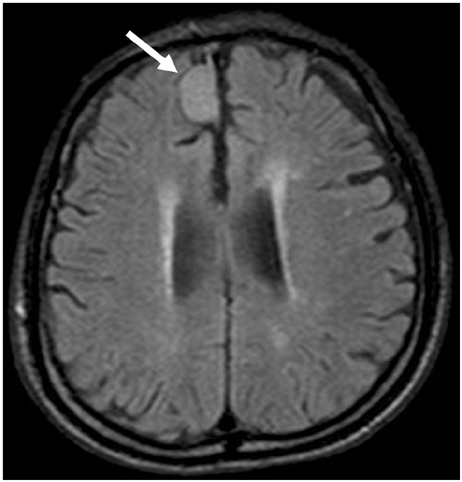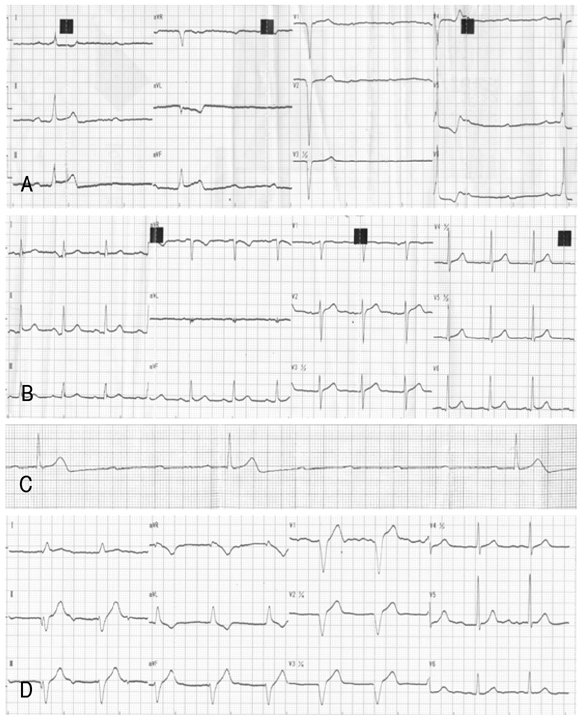Korean Circ J.
2007 Sep;37(9):449-452. 10.4070/kcj.2007.37.9.449.
Brain Tumor is a Rare Cause of both Bradycardia and Seizure
- Affiliations
-
- 1Division of Cardiology, College of Medicine The Catholic University of Korea, Daejeon, Korea. hhhsungho@naver.com
- KMID: 2093983
- DOI: http://doi.org/10.4070/kcj.2007.37.9.449
Abstract
- The association between brain tumors and cardiac asystole has rarely been reported in the medical literature. This potentially life-threatening symptom has usually been observed to arise from left temporal lobe brain tumors. Yet previously published papers have shown that cardiac asystole and bradycardia, as manifestations of epilepsy, originate from the frontal lobe of the brain. Although syncope is a common presenting symptom of a brain tumor, bradycardia and complete atrioventricular (AV) block, as the first signs of a brain tumor, have been only sporadically documented in the literature. We report here on a patient with recurrent complete AV blocks that were followed by syncope as an expression of seizures that may have arose from a brain tumor; this tumor was most likely a meningioma in the right frontal lobe. The patient required the subsequent placement of a permanent pacemaker. In conclusion, cardiac asystole may be a potentially life-threatening symptom of frontal lobe lesion of the brain. The frontal lobe may play a role in the autonomic regulation of cardiovascular responses.
Keyword
MeSH Terms
Figure
Reference
-
1. van der Sluijs BM, Renier WO, Kappelle AC. Brain tumour as a rare cause of cardiac syncope. J Neurooncol. 2004. 67:241–244.2. Soteriades ES, Evans JC, Larson MG, et al. Incidence and prognosis of syncope. N Engl J Med. 2002. 347:878–885.3. Kim WJ, Kim JY, Ju HS, et al. A case of torsades de pointes induced by complete atrioventricular block and hypokalemia. Korean Circ J. 2004. 34:220–223.4. Cha KS, Park TH, Lee CJ, et al. Torsade de pointes in advanced atrioventricular block: a cause of syncope. Korean Circ J. 1998. 28:626–631.5. Liedholm LJ, Gudjonsson O. Cardiac arrest due to partial epileptic seizures. Neurology. 1992. 42:824–829.6. Reeves AL, Nollet KE, Klass DW, Sharbrough FW, So EL. The ictal bradycardia syndrome. Epilepsia. 1996. 37:983–987.7. Locatelli ER, Varghese JP, Shuaib A, Potolicchio SJ. Cardiac asytole and bradycardia as a manifestation of left temporal lobe complex partial seizure. Ann Intern Med. 1999. 130:581–583.8. Frysinger RC, Harper RM. Cardiac and respiratory correlations with unit discharge in epileptic human temporal lobe. Epilepsia. 1990. 31:162–171.9. Wilder-Smith E. Complete atrio-ventricular conduction block during complex partial seizure. J Neurol Neurosurg Psychiatry. 1992. 55:734–736.10. Mascia A, Quarato PP, Sparano A, et al. Cardiac asystole during right frontal lobe seizures: a case report. Neurol Sci. 2005. 26:340–343.11. Tinuper P, Bisulli F, Cerullo A, et al. Ictal bradycardia in partial epileptic seizures: autonomic investigation in three cases and literature review. Brain. 2001. 124:2361–2371.12. Leung H, Schindler K, Kwan P, Elger C. Asystole induced by electrical stimulation of the left cingulated gyrus. Epileptic Disord. 2007. 9:77–81.13. Sebastiani L, Ghelarducci B. Medial prefrontal cortex early lesion effects on classical conditioned bradycardia. Exp Brain Res. 2002. 147:264–267.14. Oppenheimer SM, Cechetto DF, Hachinski VC. Cerebrogenic cardiac arrhythmias: cerebral electrocardiographic influences and their role in sudden death. Arch Neurol. 1990. 47:513–519.15. Pool JL, Ransohoff J. Autonomic effects on stimulating rostral portion of cingulated gyri in man. J Neurophysiol. 1949. 12:385–392.16. Wall DP, Davis GD. Three cerebral cortical systems affecting autonomic function. J Neurophysiol. 1951. 14:507–517.17. Benarroch EE. Bennaroch EE, editor. Overview of the organization of the central autonomic network. Central Autonomic Network. 1997. Armonk (NY): Futura Publishing;3–28.18. Oppenheimer S, Gelb A, Girvin JP, Hachinski VC. Cardiovascular effects of human insular cortex stimulation. Neurology. 1992. 42:1727–1732.19. Sato K, Shamoto H, Yoshimoto T. Severe bradycardia during epilepsy surgery. J Neurosurg Anesthesiol. 2001. 13:329–332.20. Critchley HD, Mathias CJ, Josephs O, et al. Human cingulated cortex and autonomic control: covering neuroimaging and clinical evidence. Brain. 2003. 126:2139–2152.
- Full Text Links
- Actions
-
Cited
- CITED
-
- Close
- Share
- Similar articles
-
- Brain CT findings according to seizure type in children with seizure disorder
- Dysembryoplastic Neuroepithelial Tumor: A Benign but Complex Tumor of the Cerebral Cortex
- A Case of Wilson's Disease Associated with Somatomotor Status Epileticus
- Seizures in Patients with Brain Tumors
- Brain Computerized Tomographic Findings in Various Epilepic Children



